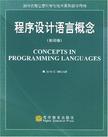程序设计语言概念(影印版)
2004-08-01
高等教育出版社
[美]JOHN C. MITCHELL
529
650000
无
本书对现代程序设计语言所运用的主要概念进行了讲解,如函数、类型、内存管理和控制。本书独到之处在于论述全面,对几种主要的面向对象程序设计语言均作了对比。另有几章讲述了对象发展历史、Simula和Smalltalk、优秀程序设计语言C++和Java。 作者讲解了基本性问题,如λ–微积分和符号语义学,并以易读的、自然的风格呈现,侧重描述这些理论的主要内涵。高级论题包括并发性与并发面向对象程序设计。有单独一章逻辑程序设计,分析针对几种问题的特殊化程序设计语言方法的重要性。 本书可以使读者了解编程语言的设计中所进行的权衡,并对他们所使用的程序设计语言的优势和弊端有更好的理解。 本书适用于高等院校计算机及相关专业本科高年级或研究生的程序设计语言类课程,对从事程序设计的专业人员也有很好的参考价值。
John C.Mithcell is professor of Computer Science at Stanford University.he has been a featured speaker at intermational conferences;has led research projects on a variety of topics.including programming lagnuage design and analysis,computer security ,and applications of mathematical logic to computer science;and has writen more than 100 research articles.Professor Mitchell was s member of the programming language subcommittee of the ACM/IEEE Curriculum 2001 standardization effort and the 202 Program Chair of the ACM Principles of Programming Languages conference.
PrefacePart 1 Functions and Foundations 1 Introduction 1.1 Programming Languages 1.2 Goals 1.3 Programming Language History 1.4 Organization: Concepts and Languages 2 Computability 2.1 Partial Functions and Computability 2.2 Chapter Summary Exercises 3 Lisp: Functions, Recursion, and Lists 3.1 Lisp History 3.2 Good Language Design 3.3 Brief Language Overview 3.4 Innovations in the Design of Lisp 3.5 Chapter Summary: Contributions of Lisp Exercises 4 Fundamentals 4.1 Compilers and Syntax 4.2 Lambda Calculus 4.3 Denotational Semantics 4.4 Functional and Imperative Languages 4.5 Chapter Summary ExercisesPart 2 Procedures, Types, Memory Management, and Control 5 The Algol Family and ML 5.1 The Algol Family of Programming Languages 5.2 The Development of C 5.3 The LCF System and ML 5.4 The ML Programming Language 5.5 Chapter Summary Exercises 6 Type Systems and Type Inference 6.1 Types in Programming 6.2 Type Safety and Type Checking 6.3 Type Inference 6.4 Polymorphism and Overloading 6.5 Type Declarations and Type Equality 6.6 Chapter Summary Exercises 7 Scope, Functions, and Storage Management 7.1 Block-Structured Languages 7.2 In-Line Blocks 7.3 Functions and Procedures 7.4 Higher-Order Functions 7.5 Chapter Summary Exercises 8 Control in Sequential Languages 8.1 Structured Control 8.2 Exceptions 8.3 Continuations 8.4 Functions and Evaluation Order 8.5 Chapter Summary ExercisesPart 3 Modularity, Abstraction, and Object-Oriented Programming 9 Data Abstraction and Modularity 9.1 Structured Programming 9.2 Language Support for Abstraction 9.3 Modules 9.4 Generic Abstractions 9.5 Chapter Summary Exercises 10 Concepts in Object-Oriented Languages 10.1 Object-Oriented Design 10.2 Four Basic Concepts in Object-Oriented Languages 10.3 Program Structure 10.4 Design Patterns 10.5 Chapter Summary 10.6 Looking Forward: Simula, Smalltalk, C++, Java Exercises 11 History of Objects: Simula and Smalltalk 11.1 Origin of Objects in Simula 11.2 Objects in Simula 11.3 Subclasses and Subtypes in Simula 11.4 Development of Smalltalk 11.5 Smalltalk Language Features 11.6 Smalltalk Flexibility 11.7 Relationship between Subtyping and Inheritance 11.8 Chapter Summary Exercises 12 Objects and Run-Time Efficiency: C++ 12.1 Design Goals and Constraints 12.2 Overview of C++ 12.3 Classes, Inheritance, and Virtual Functions 12.4 Subtyping 12.5 Multiple Inheritance 12.6 Chapter Summary Exercises 13 Portability and Safety: Java 13.1 Java Language Overview 13.2 Java Classes and Inheritance 13.3 Java Types and Subtyping 13.4 Java System Architecture 13.5 Security Features 13.6 Java Summary ExercisesPart 4 Concurrency and Logic Programming 14 Concurrent and Distributed Programming 14.1 Basic Concepts in Concurrency 14.2 The Actor Model 14.3 Concurrent ML 14.4 Java Concurrency 14.5 Chapter Summary Exercises 15 The Logic Programming Paradigm and Prolog 15.1 History of Logic Programming 15.2 Brief Overview of the Logic Programming Paradigm 15.3 Equations Solved by Unification as Atomic Actions 15.4 Clauses as Parts of Procedure Declarations 15.5 Prolog's Approach to Programming 15.6 Arithmetic in Prolog 15.7 Control, Ambivalent Syntax, and Meta-Variables 15.8 Assessment of Prolog 15 9 Bibliographic Remarks 15.10 Chapter SummaryAppendix A Additional Program Examples A.1 Procedural and Object-Oriented OrganizationGlossaryIndex

无
该作者刚刚成为ACM Fellow,学术大牛了都。快进货吧,我还指着该书搞科研呢
像很多经典一样在国内被埋没。。。